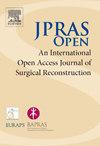使用乳头乳晕复合体带蒂技术治疗巨乳症的缩乳术中的感觉保留:一项系统回顾和荟萃分析。
IF 1.5
Q3 SURGERY
引用次数: 0
摘要
背景:巨乳症是一种以乳房组织过多为特征的致残疾病。历史上,自由乳头移植(FNG)一直是首选,优先考虑乳头乳晕复合体(NAC)血管。携带NAC蒂技术,最常用于乳房肥大的情况下,根据最近的证据,已被建议作为一种可行的选择,以减少NAC坏死率和改善预后。然而,目前缺乏对该技术在感觉保存方面的详细结果评估。因此,本系统综述和荟萃分析旨在评估巨乳症患者携带nac椎弓根技术相关感觉丧失的风险。方法:根据PRISMA指南,文献检索确定了报告携带nac椎弓根技术切除超过1000 g脂肪腺组织的术后敏感性的研究。然后,进行了比例荟萃分析,以评估通过nac携带椎弓根技术的感觉丧失的总率。结果:17项研究(843例患者,1685个乳房)符合纳入标准。荟萃分析显示,携带nac的椎弓根技术的感觉丧失风险极低(1.3%;95%置信区间:0.7-2.0),无显著统计学异质性。结论:本研究首次对带nac椎弓根技术在巨乳症中的感觉保存效果进行了综合评价。携带nac的椎弓根技术因其安全性和良好的功能效果而成为首选。手术谨慎仍然是至关重要的,可以根据需要选择切换到FNG,以确保患者安全和手术成功。进一步研究不同携带nac的椎弓根技术对感觉保存的影响是必要的。本文章由计算机程序翻译,如有差异,请以英文原文为准。
Sensory preservation in reduction mammoplasty using the nipple-areola complex-carrying pedicle technique for gigantomastia: A systematic review and meta-analysis
Background
Gigantomastia is a disabling condition characterized by excess breast tissue. Historically, free nipple graft (FNG) has been preferred, prioritizing the nipple-areola complex (NAC) vascularity. The NAC-carrying pedicle technique, which is most commonly used in case of hypertrophy of the breast, has been suggested as a viable alternative for gigantomastia according to recent evidence, with reduced rates of NAC necrosis and improved outcomes. Nevertheless, a detailed outcome evaluation of the technique in terms of sensory preservation is currently lacking. Therefore, this systematic review and meta-analysis aimed to assess the risk of sensory loss associated with the NAC-carrying pedicle technique in cases of gigantomastia.
Methods
Following the PRISMA guidelines, a literature search identified studies reporting postoperative sensitivity with the NAC-carrying pedicle technique in resections exceeding 1000 g of adipo-glandular tissue. Then, a proportion meta-analysis was conducted to assess the pooled rate of sensation loss through the NAC-carrying pedicle technique.
Results
Seventeen studies (843 patients, 1685 breasts) met the inclusion criteria. The meta-analysis revealed an exceptionally low risk of sensory loss with the NAC-carrying pedicle technique (1.3%; 95% confidence interval: 0.7-2.0), without significant statistical heterogeneity.
Conclusion
This study provides the first comprehensive evaluation of sensory preservation with the NAC-carrying pedicle technique in gigantomastia. The NAC-carrying pedicle technique emerges as the first choice, offering safety and favorable functional outcomes. Surgical caution remains crucial with the option to switch to FNG as required, ensuring patient safety and procedure success. Further research on the impact of different NAC-carrying pedicle techniques on sensory preservation is warranted.
求助全文
通过发布文献求助,成功后即可免费获取论文全文。
去求助
来源期刊

JPRAS Open
Medicine-Surgery
CiteScore
1.60
自引率
0.00%
发文量
89
审稿时长
22 weeks
期刊介绍:
JPRAS Open is an international, open access journal dedicated to publishing case reports, short communications, and full-length articles. JPRAS Open will provide the most current source of information and references in plastic, reconstructive & aesthetic surgery. The Journal is based on the continued need to improve surgical care by providing highlights in general reconstructive surgery; cleft lip, palate and craniofacial surgery; head and neck surgery; skin cancer; breast surgery; hand surgery; lower limb trauma; burns; and aesthetic surgery. The Journal will provide authors with fast publication times.
 求助内容:
求助内容: 应助结果提醒方式:
应助结果提醒方式:


